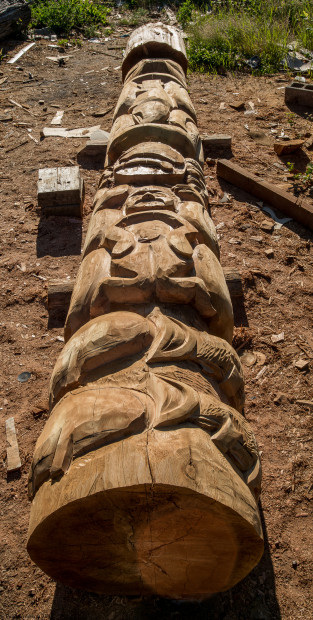The following is research I collected on the commission, creation and ritual of totem poles--an indigenous craft that had always amazed me. Since I have been working with wood, I think it is important for me to investigate different styles of carving, specifically that of primitive peoples to provide myself with inspiration and ideas on bettering or changing my technique. In my research, I came to see that the totem poles are incredible without color, but when painted with brilliantly pigmented paints they are all the more powerful. Color emphasizes the austere features of each individual totem and allows the eye to better define each creature. For this reason, I am more inspired to use color in my latest relief carving. As far as content is concerned, I love the stories that are so integral to each and every totem pole, and I would like to attempt a vertical carving that tells a story in a similar way (though perhaps not on as large of scale--not yet).
| According to Keri Dearborn, author of Totem Poles, 19th century Tlingit, Haida, Kwakiutl, Tsimshian, and Gitksan peoples of the Pacific Northwest (primarily Alaska and British Columbia) were carvers of these poles. Very few remain, but the Society for Science and the Public reports that elders have tried to pass on the skill of carving to younger generations in hopes of preserving it. Eighty-seven boys of the Civilian Conservation Corps restored 100 totem poles in Alaska after learning the skills of their ancestors. Dearborn defines totem poles as the Pacific Northwest native’s visual records of their history and legends. Knowledge of these poles’ commission and creation, ritual, and significance help to deeper appreciate this indigenous craft. Commissioning someone to create a totem pole is the first step in the totem pole process. In this step we encounter the commissioner and the carver. The commissioner requests figures and decides their order, and he or she ultimately pays for the commission. Marius Barbeau, a writer for the Geographical Review notes in his research that often times in some tribes the family members will work together to make their own totem pole (and do not commission outsiders). The carver is a high-ranking individual in the tribe, and admired for his talent. In her article on totem poles, Keri Dearborn also explains how the carving trade passed from father to son, and master carvers typically worked with several apprentices to teach and train them in this unique craft. Once commissioned, the carver decides how the figures will be presented upon the pole. In the creation of the totem pole either the family or the commissioned carvers will cut down a cedar tree. Linda and Carl Muggli, well known totem pole carvers residing in Minneapolis, claim that the tree must be debarked right away to keep from worms. Then the design is sketched on log with charcoal. Dearborn describes the process in which the poles are carved: 1st the carver chips basic shape of the figures with a special adze tool (which is like a curved hammer with a large gouge on the end). Then he uses antler chisels, beaver-tooth or metal carving knives, or a stone maul and hammer to carve details. Finally, he paints the pole with long-lasting paint made of a mixture of plants/minerals and salmon eggs--traditional colors are red and black, accented with brown, green, white, and yellow. After the creation of the totem pole a village would gather to celebrate. These public gatherings were to commemorate and remember special people and events. For example, in the instance of a chief’s death his son must have commissioned a totem pole before he claimed his father's inheritance--his village gathered to recognize his new position and to honor their former chief. The village would then have a feast called a "potlatch" before erecting the pole. In her article, Dearborn stresses the fact that raising the totem pole takes a lot of manpower considering poles can be anywhere from 6 to 70 ft tall. Poles were commonly placed to the front-center of a family’s longhouse, and sometimes had a hole or arch to form a doorway. Perhaps the most important aspect of totem poles is their story. Dearborn writes that the final part in the totem pole ceremony consisted of an elder explaining the significance of the totems (essentially telling the story behind the creation of the pole) in order to teach the history and heritage of their ancestors to the younger generations. Totems depict mythological creatures, animals, or plants. Barbeau claims that the most common symbols included the raven, eagle, wolf, beaver, bear. Less popular ones included the frog, whale, and fireweed. Furthermore, clans were very possessive of their special emblem. These symbols displayed pride, and helped the clan members to recognize their kin in other villages. Interestingly, the poles are read from the bottom up with the most important figure on the very bottom and the clan emblem on the very top. Now we know that every villager plays a special role in the totem pole process. The commissioner initiates the construction after an occasion. The carver creates the visual record. The village gathers, feasts, and together raises the pole. And finally, the elder tells the story behind the pole to his people in hopes of preserving the tales and history that make them who they are. Next time you read a newspaper, or one of the school bulletins, or you flip through an old photo album, just try to imagine standing at the foot of one of these great totem poles. | The village gathers, feasts, and together raises the pole. And finally, the elder tells the story behind the pole to his people in hopes of preserving the tales and history that make them who they are. |


